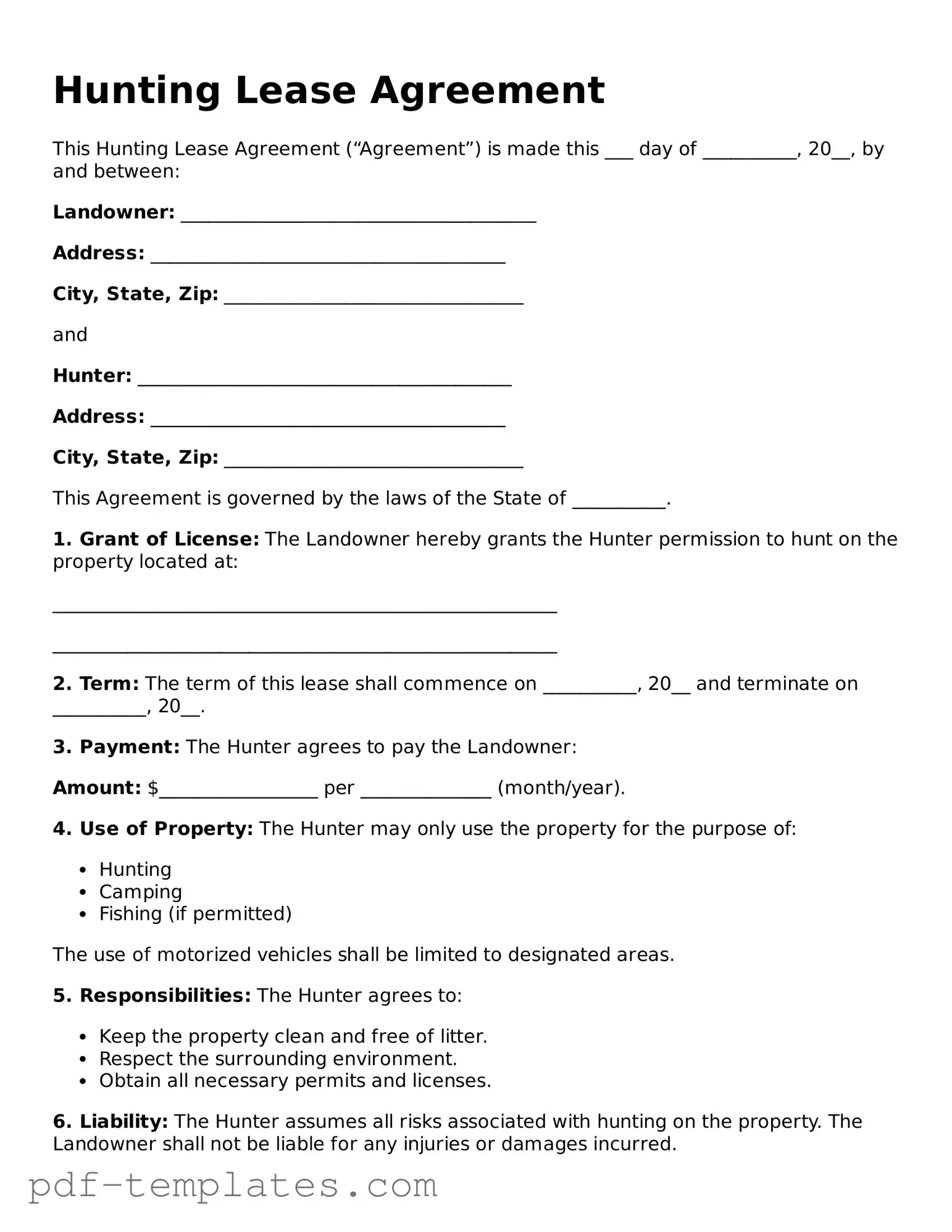The Hunting Lease Agreement is similar to a Residential Lease Agreement in that both documents outline the terms under which one party can use another party’s property. In a Residential Lease Agreement, a landlord permits a tenant to occupy a residential space, while in a Hunting Lease Agreement, a landowner allows hunters to access their land for recreational purposes. Both agreements typically specify the duration of the lease, the rental amount, and the responsibilities of each party, ensuring clarity and legal protection for both sides.
Another document that bears resemblance to the Hunting Lease Agreement is the Commercial Lease Agreement. This type of lease is used when a business rents a commercial space from a property owner. Similar to the Hunting Lease, it outlines specific terms such as rent, duration, and permitted uses of the property. Both documents serve to protect the rights of the lessor and lessee, detailing what is permissible and what is not during the lease period.
The Agricultural Lease Agreement also shares similarities with the Hunting Lease Agreement. In an Agricultural Lease, a landowner allows a farmer to cultivate crops or raise livestock on their land. Both agreements typically include stipulations regarding land use, duration, and payment terms. They ensure that both parties understand their rights and responsibilities, fostering a clear relationship between landowners and users.
The Equipment Lease Agreement is another document that parallels the Hunting Lease Agreement. This agreement allows one party to use equipment owned by another party for a specified period. Just as the Hunting Lease details conditions for land use, the Equipment Lease Agreement outlines terms such as rental fees, maintenance responsibilities, and the duration of the lease. Both documents aim to protect the interests of the owner while allowing the lessee to utilize the property or equipment as needed.
A similar document is the Event Venue Rental Agreement, which permits individuals or organizations to use a specific venue for events. Much like the Hunting Lease Agreement, it specifies the terms of use, including duration, rental fees, and any restrictions on activities. Both agreements are designed to ensure that the property is used appropriately and that the rights of the property owner are upheld.
The License Agreement is another comparable document. This agreement grants permission for one party to use another party's property under certain conditions. While a Hunting Lease Agreement allows for hunting on a specific piece of land, a License Agreement might permit activities like fishing or camping. Both documents clarify the rights granted and the limitations imposed, ensuring that both parties are aware of their obligations.
The Sublease Agreement is also akin to the Hunting Lease Agreement. A sublease occurs when a tenant rents out a portion of the leased property to another party. Similar to the Hunting Lease, it outlines terms such as duration and payment, ensuring that all parties understand their rights and responsibilities. Both agreements serve to manage the use of property and protect the interests of the original owner.
The Timeshare Agreement has similarities with the Hunting Lease Agreement in that it allows multiple parties to share access to a property. In a timeshare, individuals purchase the right to use a property for a specified time each year, while a Hunting Lease grants access to hunters for a defined period. Both agreements must clearly delineate usage rights, duration, and payment terms to avoid disputes among users.
The California Lease Agreement form is a vital document that not only lays out terms for residential rental but similarly emphasizes the need for clarity and respect in all lease agreements. Understanding these principles is essential for anyone entering into a contractual relationship regarding property usage. For further guidance on this topic, you can find more information and access the form here: https://pdftemplates.info/california-lease-agreement-form/.
The Joint Venture Agreement can also be compared to the Hunting Lease Agreement. In a joint venture, two or more parties collaborate for a specific purpose, often involving shared resources. While the Hunting Lease Agreement focuses on land use for hunting, a Joint Venture Agreement may involve shared access to resources for business or recreational purposes. Both documents require clear terms to define the roles and responsibilities of each party involved.
Finally, the Partnership Agreement shares characteristics with the Hunting Lease Agreement. This document outlines the terms of a partnership between two or more individuals or entities, including the sharing of resources or property. Similar to the Hunting Lease, it defines roles, responsibilities, and expectations, ensuring that all parties are on the same page regarding the use of shared assets.
